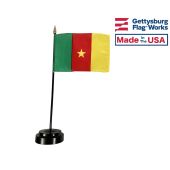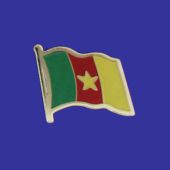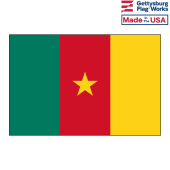Buy Cameroon Flags

Flag of Cameroon
The Cameroon flag for almost half of a century. It is not the first flag of Cameroon, and the current flag's design is derived from the first flag that the country adopted after it became an independent nation. It does not show any significant influence from the colonial flags that represented Cameroon while it was part of the German and British Empires.
- Capital of Cameroon: Yaounde
- Area of Cameroon: 469,440 sq. km
- Languages used in Cameroon: 24 major African language groups, English (official), French (official)
- Religions in Cameroon: Indigenous beliefs, Christian, Muslim
Colors and Symbolism of the Cameroon Flag
The modern flag of Cameroon is a vertical tricolor of green, red, and yellow with a yellow star in the center of the red bar. The green bar represents the forests that cover the southern part of Cameroon, while the yellow bar represents the savanna that covers the northern part of the country as well as the bright sun that shines down upon it. The red bar is a symbol of national unity. The yellow star is also a symbol of unity, and it is placed in the center of the red bar in order to emphasize that symbolism. The flag's colors were taken from the national flag of Ethiopia and their use gives the Cameroon flag meaning as a symbol of solidarity with the other nations of Africa and independence from European rule. The Cameroon flag shares those colors with many other nations in Africa, but it was one of the earliest flags to adopt them.
History of the Flags of Cameroon
The history of the flags of Cameroon begins with its time as a European colony. Cameroon gained its first flag when it became part of the German Empire in 1884. The flag consisted of the flag of the German Empire, which was a horizontal tricolor of black, white, and red, with a red shield that displayed a white elephant in the center. The combination of the German flag with the elephant gave the colonial Cameroon flag meaning as a symbol of German authority over the natural resources of Africa.
Germany lost control over Cameroon after the first world war, and control over the region was divided between Britain and France. The French portion of the country did not use a flag, but the British section adopted a standard British colonial flag in 1922. It had a solid blue field with the Union Jack in the canton and the colonial seal in the fly. It fell out of use when the nation reunified and gained its independence in 1961. A flag that resembled the modern design but lacked stars was in use prior to independence, but it did not have official sanction. The nation adopted a precursor to the modern flag that featured two stars in the canton rather than the single star of the current design in 1961. It was replaced with the modern flag in 1975.






